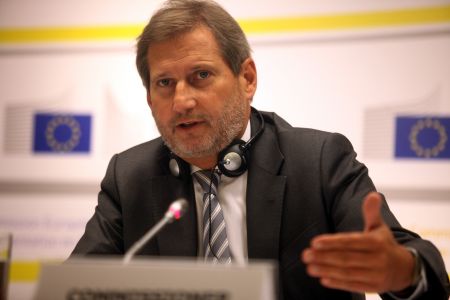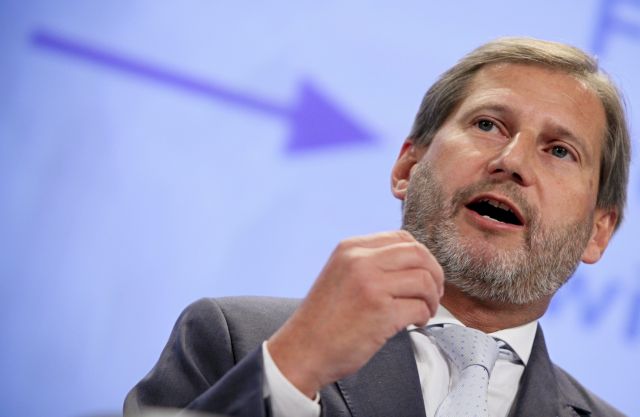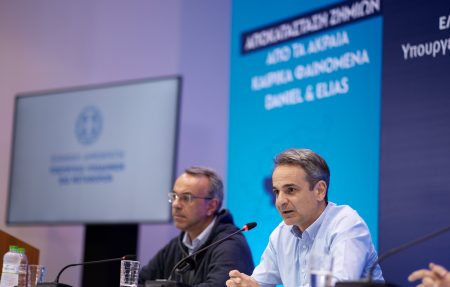Strict message to Hungary and Poland to respect the «Europe of Law» that is being tested by the pandemic and to open the package of 1.8 trillion. Euros with the first disbursements at the beginning of 2021 is sent by Commissioner Johannes Hahn in his interview with «Vima tis Kyriakis».
On the eve of the Brussels Summit, where this hot issue is expected to be discussed in the background, Mr Hahn said: «I hope that Poland and Hungary will resolve their objections. Businesses, citizens and programs across Europe are demanding the rapid release of money from both the EU budget and the Recovery Fund.
All Eurozone countries, including Greece, have pinned their hopes on the economy on the Recovery and Resiliency Facility. Where are we, at this point, regarding the process of setting up and joining it? And what are the difficulties for it to work from 1-1-2021?
The MFF Regulation agreed by the negotiators on 10 November must be endorsed and adopted by the European Parliament and the Council. In parallel, work continues towards a final adoption of all other elements of the package, including the sectoral legislation and the Own Resources Decision.
In the case of the Own Resources Decision, which will enable the Commission to borrow, ratification by all Member States in line with their constitutional requirements is also needed. The European Parliament, at its September plenary, has already provided its positive opinion on this piece of legislation. The adoption of this Decision by the Council is the next step.
As for the Recovery and Resilience Facility, trilogues between the European Parliament, the Council and the Commission on the regulation of the RRF started on 13 November. It is important that the institutions find a quick agreement, the Commission having the role of a facilitator. The Recovery and Resilience Facility should become operational as soon as possible if we want to be able to approve the recovery and resilience plans, start implementation and make the first disbursements in 2021.
Member States can formally submit their recovery and resilience plans for assessment from the moment the Facility is legally in force. The deadline for the submission of the plans is 30 April 2021. Nevertheless, the Commission has encouraged Member States to submit their preliminary draft plans from 15 October 2020 on. The process takes place in form of a dialogue, following the pattern of the European Semester.
The Commission provided additional guidance and a template to help Member States prepare and present their recovery and resilience plans in a coherent way.
There are serious implications with the attitude of Hungary and Poland. Hungary effectively threatens to veto EU Budget and the Recovery Plan, if “common values and the rule of law are set as condition for each member state to receive EU funds”.
On 16 November 2020, Coreper II did not reach a consensus on the legal texts for the MFF and recovery package due to Hungary and Poland opposition to the Rule of Law conditionality mechanism, which is very regrettable, given the great urgency in times of crisis.
The political agreements reached in the trilogues on the different elements of the package are fully in line with the conclusions of the European Council from 21 July 2020. The German Presidency is currently trying to solve the deadlock.
This is the only way to ensure that money will flow to all EU Member States, as of 1 January 2021. Citizens, companies and regions most affected by the coronavirus and its consequences across Europe rely on us, we have to deliver on their expectations.
European institutions have taken their responsibilities, agreeing on a package worth EUR 1.8 trillion, which represents roughly 15% of the Union’s GDP. This unprecedented volume is an adequate response to the current unprecedented crisis.
With more public money available at Union level than ever before, the European Council in July underlined the importance of the protection of the Union’s financial interests and of the respect of the rule of law. Expenditure financed by Union taxpayers must be shielded from any kind of fraud, corruption or other irregularities.This requires respect for the rule of law, including an effective and independent judiciary.
On 5 November the European Parliament and the Council have agreed on a general regime of conditionality for the protection of the Union budget. This regime establishes the rules necessary for the protection of the Union budget in the case of breaches of the principles of the rule of law in the Member States. The conditions for implementing this regime are objective and will be applied in the same manner to all Member States. There will be no arbitrariness or double standards.
The process ensures fair treatment of Member States. They will have three opportunities to present their views in the event that the mechanism is activated: first, on the Commission’s initial findings, second on the measures that the Commission may propose, and finally before the Council’s final decision. Exceptionally, the Member State concerned may request the President of the European Council to refer the matter for discussion at the next European Council. Any measure proposed by the Commission will need to be approved by Member States in the Council with qualified majority.
And of course, all decisions adopted under the regulation – as well as the validity of the regulation itself – are subject to judicial review by the Court of Justice of the European Union. This mechanism should be in the interest of all Member States, as they are accountable that EU money is spent according to the rules. I hope therefore that also Poland and Hungary will finally give up their objection. Businesses, citizens and projects all over Europe need a quick delivery of money from the MFF as well as of the recovery fund.
What will be the priorities of the RRF? In other words, which reforms and which investments will be funded as a matter of priority?
Member States will prepare recovery and resilience plans that set out a coherent package of reforms and public investment projects. To benefit from the support of the Facility, these reforms and investments should be implemented by 2026. The plans should effectively address challenges identified in the European Semester, particularly the country-specific recommendations adopted by the Council. The plans should also include measures to address the current challenges and contribute to the EU’s green and digital transition.
Each plan is expected to contribute to the four dimensions outlined in the 2021 Annual Sustainable Growth Strategy, which launched this year’s European Semester cycle, namely environmental sustainability, productivity, fairness and macroeconomic stability
The Recovery and Resilience Facility offers an unprecedented opportunity to speed up the recovery in Europe and reinforce the EU’s transformation via the twin transitions: green and digital. The Commission will assess the national plans against the following targets:
o Each recovery and resilience plan will have to include a minimum of 37% of expenditure related to climate. Progress towards other environmental objectives is also important, in line with the European Green Deal.
o Each recovery and resilience plan will have to include a minimum of 20% of expenditure to foster the digital transition. The Commission is developing a methodology to ensure investment is channelled to both infrastructure and digital capacities.
You recently stated that the issuance of new bonds of the European Union is accelerating, saying: «I am convinced that we will be able to reach a decision this fall». Does this open a new page in the so-called «reciprocity» of debt?
The issuance of debt issued by the EU will indeed considerably increase in the coming months and years, particularly as a result of the implementation of the SURE initiative as well as Next Generation EU. Both are initiatives to address the consequences of the COVID-19 pandemic.
While debt issuance for the SURE initiative is already taking place with 3 very successful issuances of social bonds, with disbursements to Member States of around 40 bn EUR, borrowing by the EU for Next Generation EU can only start after an agreement with the European Parliament on the MFF/NGEU package. I am confident that we will reach this agreement in December the latest. The final step after this agreement will be the ratification of the Own Resources Decision at national level. Once this process is concluded, Next Generation EU can be implemented.
Both initiatives will benefit Greece by providing tangible support for containing the negative economic impact of the crisis and by reigniting sustainable economic growth.

You have experience in managing the Structural Funds. How will these «development tools», including Recovery Fund, work together?
The Facility and other EU funds/instruments are fully complementary. The Recovery and Resilience Facility will support medium- and longer-term reforms and investments, notably in green and digital technologies, with a sustainable and lasting impact on the productivity and economic and social resilience of the economy of the Member State and the Union.
Resources under the RRF can complement cohesion policy resources, which should address long-term interventions valid for the full next financing period 2021-2027. The use of various available EU funds by the Member States will need to take into account the specific situation of the Member State, including regional and local specificities and the balance between RRF and national cohesion policy allocations.
REACT-EU will target crisis repair actions in the shorter-term related to labour markets, healthcare and SMEs (liquidity and solvency support), and essential investments for the green and digital transitions. It will provide immediate and direct support to Member States’ economies.
The Facility is also complementary to the range of measures already developed in response to the current coronavirus pandemic such as the amendment to the cohesion policy regulation, the Coronavirus Response Investment Initiatives and SURE, but also actions taken by other institutions such as the EIB’s Guarantee Fund for Workers and Businesses and the ESM’s Pandemic Crisis Support.
Before taking on your new duties – of budget and administration – you had the opportunity to get to know Greece and closely follow the Prespa agreement. What is your experience of this admittedly positive development for the Balkan region and for the European perspective?
Looking back, I have to state that the Prespa agreement was certainly one of the absolute highlights of my previous mandate when I was responsible for Enlargement and Neighbourhood Policy. The agreement sent a strong signal of peace and reconciliation to the whole region and beyond. I hope that the Prespa agreement will also inspire Bulgaria to accept North Macedonia’s identity and to settle the conflict about different interpretations of both countries’ history. It is important for the whole region to focus on the future instead of dealing with the past.
Good neighbourly relationships are not only essential for a positive development in the region, but a pre-requisite for EU accession. No country will be accepted by the EU that has unsolved conflicts with its neighbours. That’s why it is so important also to solve finally the conflict between Serbia and Kosovo.
Independently of the progress and settlements which have still to be made, I am convinced that the Western Balkans will join the EU in foreseeable future. These countries are already part of Europe and it is in the EU’s own interest to create peace and stability in their immediate neighbourhood via their EU integration. As I am always saying: “Exporting stability instead of importing instability”. This is the essence of a forward-looking Enlargement and Neighbourhood Policy, to the benefit of all partners.





